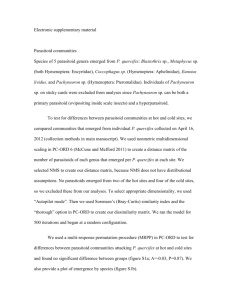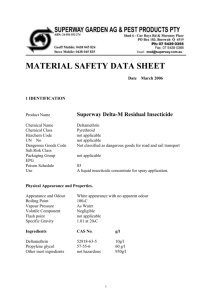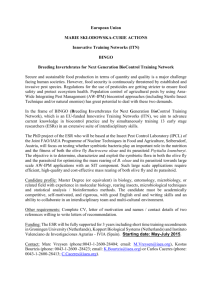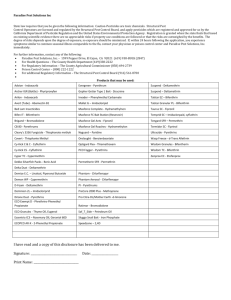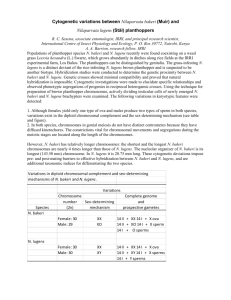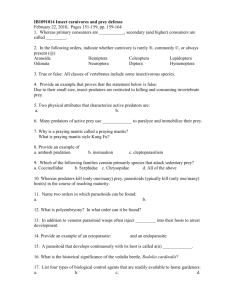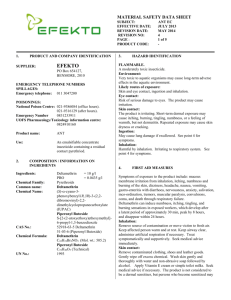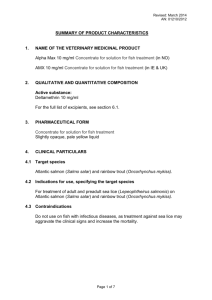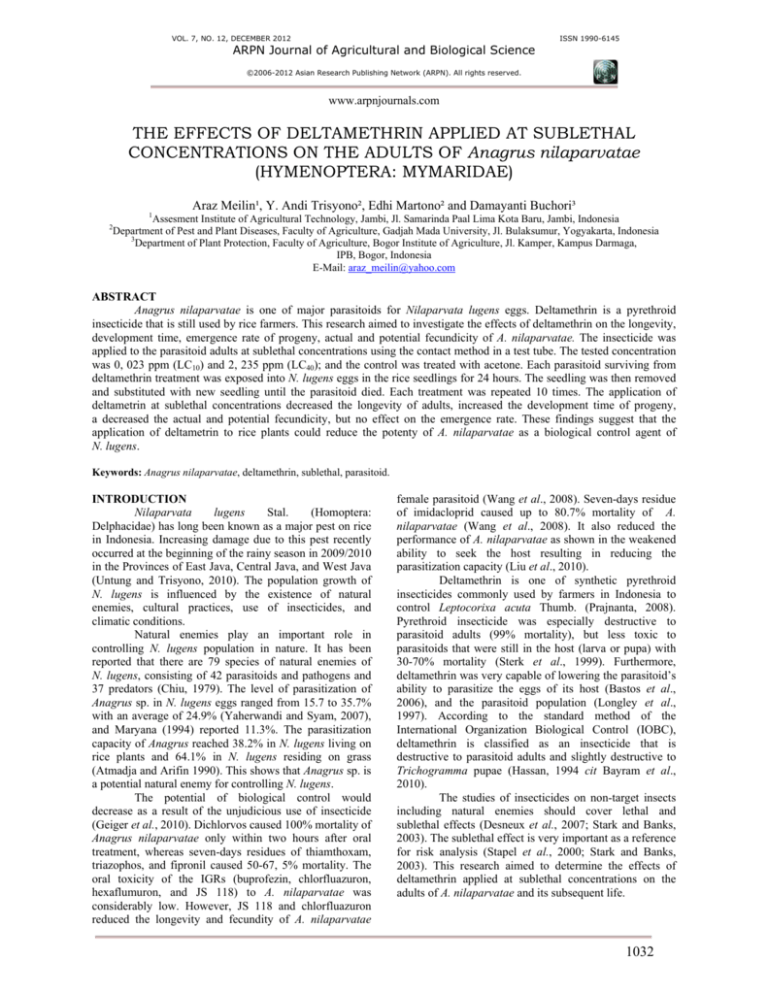
VOL. 7, NO. 12, DECEMBER 2012
ISSN 1990-6145
ARPN Journal of Agricultural and Biological Science
©2006-2012 Asian Research Publishing Network (ARPN). All rights reserved.
www.arpnjournals.com
THE EFFECTS OF DELTAMETHRIN APPLIED AT SUBLETHAL
CONCENTRATIONS ON THE ADULTS OF Anagrus nilaparvatae
(HYMENOPTERA: MYMARIDAE)
Araz Meilin¹, Y. Andi Trisyono², Edhi Martono² and Damayanti Buchori³
1
Assesment Institute of Agricultural Technology, Jambi, Jl. Samarinda Paal Lima Kota Baru, Jambi, Indonesia
2
Department of Pest and Plant Diseases, Faculty of Agriculture, Gadjah Mada University, Jl. Bulaksumur, Yogyakarta, Indonesia
3
Department of Plant Protection, Faculty of Agriculture, Bogor Institute of Agriculture, Jl. Kamper, Kampus Darmaga,
IPB, Bogor, Indonesia
E-Mail: araz_meilin@yahoo.com
ABSTRACT
Anagrus nilaparvatae is one of major parasitoids for Nilaparvata lugens eggs. Deltamethrin is a pyrethroid
insecticide that is still used by rice farmers. This research aimed to investigate the effects of deltamethrin on the longevity,
development time, emergence rate of progeny, actual and potential fecundicity of A. nilaparvatae. The insecticide was
applied to the parasitoid adults at sublethal concentrations using the contact method in a test tube. The tested concentration
was 0, 023 ppm (LC10) and 2, 235 ppm (LC40); and the control was treated with acetone. Each parasitoid surviving from
deltamethrin treatment was exposed into N. lugens eggs in the rice seedlings for 24 hours. The seedling was then removed
and substituted with new seedling until the parasitoid died. Each treatment was repeated 10 times. The application of
deltametrin at sublethal concentrations decreased the longevity of adults, increased the development time of progeny,
a decreased the actual and potential fecundicity, but no effect on the emergence rate. These findings suggest that the
application of deltametrin to rice plants could reduce the potenty of A. nilaparvatae as a biological control agent of
N. lugens.
Keywords: Anagrus nilaparvatae, deltamethrin, sublethal, parasitoid.
INTRODUCTION
Nilaparvata
lugens
Stal.
(Homoptera:
Delphacidae) has long been known as a major pest on rice
in Indonesia. Increasing damage due to this pest recently
occurred at the beginning of the rainy season in 2009/2010
in the Provinces of East Java, Central Java, and West Java
(Untung and Trisyono, 2010). The population growth of
N. lugens is influenced by the existence of natural
enemies, cultural practices, use of insecticides, and
climatic conditions.
Natural enemies play an important role in
controlling N. lugens population in nature. It has been
reported that there are 79 species of natural enemies of
N. lugens, consisting of 42 parasitoids and pathogens and
37 predators (Chiu, 1979). The level of parasitization of
Anagrus sp. in N. lugens eggs ranged from 15.7 to 35.7%
with an average of 24.9% (Yaherwandi and Syam, 2007),
and Maryana (1994) reported 11.3%. The parasitization
capacity of Anagrus reached 38.2% in N. lugens living on
rice plants and 64.1% in N. lugens residing on grass
(Atmadja and Arifin 1990). This shows that Anagrus sp. is
a potential natural enemy for controlling N. lugens.
The potential of biological control would
decrease as a result of the unjudicious use of insecticide
(Geiger et al., 2010). Dichlorvos caused 100% mortality of
Anagrus nilaparvatae only within two hours after oral
treatment, whereas seven-days residues of thiamthoxam,
triazophos, and fipronil caused 50-67, 5% mortality. The
oral toxicity of the IGRs (buprofezin, chlorfluazuron,
hexaflumuron, and JS 118) to A. nilaparvatae was
considerably low. However, JS 118 and chlorfluazuron
reduced the longevity and fecundity of A. nilaparvatae
female parasitoid (Wang et al., 2008). Seven-days residue
of imidacloprid caused up to 80.7% mortality of A.
nilaparvatae (Wang et al., 2008). It also reduced the
performance of A. nilaparvatae as shown in the weakened
ability to seek the host resulting in reducing the
parasitization capacity (Liu et al., 2010).
Deltamethrin is one of synthetic pyrethroid
insecticides commonly used by farmers in Indonesia to
control Leptocorixa acuta Thumb. (Prajnanta, 2008).
Pyrethroid insecticide was especially destructive to
parasitoid adults (99% mortality), but less toxic to
parasitoids that were still in the host (larva or pupa) with
30-70% mortality (Sterk et al., 1999). Furthermore,
deltamethrin was very capable of lowering the parasitoid’s
ability to parasitize the eggs of its host (Bastos et al.,
2006), and the parasitoid population (Longley et al.,
1997). According to the standard method of the
International Organization Biological Control (IOBC),
deltamethrin is classified as an insecticide that is
destructive to parasitoid adults and slightly destructive to
Trichogramma pupae (Hassan, 1994 cit Bayram et al.,
2010).
The studies of insecticides on non-target insects
including natural enemies should cover lethal and
sublethal effects (Desneux et al., 2007; Stark and Banks,
2003). The sublethal effect is very important as a reference
for risk analysis (Stapel et al., 2000; Stark and Banks,
2003). This research aimed to determine the effects of
deltamethrin applied at sublethal concentrations on the
adults of A. nilaparvatae and its subsequent life.
1032
VOL. 7, NO. 12, DECEMBER 2012
ISSN 1990-6145
ARPN Journal of Agricultural and Biological Science
©2006-2012 Asian Research Publishing Network (ARPN). All rights reserved.
www.arpnjournals.com
MATERIALS AND METHODS
Nilaparvata lugens
The initial population of N. lugens was obtained
from the laboratory of Toxicology, Faculty of Agriculture,
University of Gadjah Mada (Yogyakarta, Indonesia). This
population is extremely susceptible to insecticide. Since
1985, it has never been exposed to any insecticide and
there has been no addition of N. lugens population from
the field. N. lugens has been reared using an established
laboratory procedure utilizing rice seedling of Cisadane
variety.
Approximately 100 pairs of N. lugens adults were
taken from the stock population (the 360th generation) with
an aspirator as starter or initial population. The starters
were put into a breeding jar (with an upper diameter of 20
cm and a lower diameter of 17 cm, 20 cm hight)
containing rice seedlings (7 days after germination) for
egg-laying. After 3-4 days, the females laid eggs and about
5-7 days later the eggs hatched, producing nymphs. The
nymphs were reared in the rice seedlings until they
became adults. When the rice plants turned yellow,
changing with the new rice seedlings was done by lifting
the old plants and putting them over the new plants by
turning them. The old plants were supported with wire to
prevent them from covering the new plants. N. lugens
moved from the old to the new plants. Three days later the
old plants were removed. The plants used for feeding were
7-day-old rice seedlings after germination.
Anagrus nilaparvatae
The initial parasitoid population was obtained
from the rice field in Bantul (Yogyakarta, Indonesia) by
trapping (Trisyono, 1991; Maryana, 1994; Yaherwandi
and Syam, 2007). The rearing of A. nilaparvatae was done
by using a plastic box, which is a cage measuring
14x18.5x18.5 cm made of mica plastic (0.6 mm thick) and
a test tube (10 cm long, 1 cm in diameter) was attached in
the middle of the front side. This tube served to facilitate
parasitoid harvest, because newly emerged parasitoids
flew toward the tube. The harvest was done by substituting
the old tube containing the parasitoids with the new one.
On the other side (opposite the test tube), a screen cloth
(6x10 cm) was provided for aeration. At the bottom of the
plastic box was a plastic tray (15x20x3 cm) containing soil
with a thickness of 1 cm and rice seedlings of the
Cisadane variety aged one week containing N. lugens
eggs. These eggs were produced by 100 gravid females of
N. lugens per box. Honey was applied to each wall of the
plastic box to provide feed for the parasitoids. Fifty female
parasitoids were released into each box and their progeny
emerged 9-13 days later.
Insecticide
The insecticide used was deltamethrin (technical
grade) containing 97% active ingredient provided by PT
Agricorn (Jl. Siliwangi No. 68 Bogor, Indonesia).
Toxicity of deltametrin to Anagrus nilaparvatae
A bioassay was carried out to determine the LC10
and LC40 values of deltamethrin on A. nilaparvatae. This
was done by using the method developed by Desneux et
al. (2006) with modification on the concentrations used.
Based on the result from the preliminary test, six
concentrations (starting from 0.015625-16 ppm in acetone)
were chosen to obtain 5-95% parasitoid mortality. The
series of concentrations were prepared by four times
dilution. Each treatment used 10 adults, and each
treatment was repeated four times. Acetone was used on
the control. The contact method was adopted using a test
tube (1.3 cm in diameter, 10 cm in length). The test tube
was wetted with 0.1 ml solution of each concentration.
The test tube was rolled so that the whole inner surface
was covered with deltamethrin solution and then was
allowed to evaporate for one hour. Ten female parasitoids
were put into the test tube and allowed to be exposed to
the insecticide for one hour. The surviving parasitoids
were then moved to the clean test tube containing a rice
seedling which had been infested with N. lugens eggs aged
two days and had 10% honey solution on the aluminium
foil (0.5x4 cm). The test tube was capped with fine gauze
cloth. The mortality of parasitoid was observed 24 hours
after treatment. A probit analysis (Finney, 1971) was
performed using Software SAS 9.3.1 Portable. The data
would be analyzed if the mortality of the control was
<20%.
The effects of deltamethrin applied at sublethal
concentrations on the adults of Anagrus
nilaparvatae and its subsequent life
A. nilaparvatae adults were treated with
deltamethrin applied at sublethal concentrations (LC10 and
LC40) using the contact method, whereas the control was
treated with acetone. The contact method used was the
same as the one used in the testing for the toxicity of
deltamethrin to A. nilaparvatae.
The plants used in this research were one-weekold rice seedlings. A one-week-old rice seedling was
enclosed with tissue paper measuring 1x3 cm (4 layers) at
the root and then wrapped in an aluminium foil of the
same size. The tissue paper was immersed in water to keep
the plant fresh. The edge of the seedling was cut to make
its length the same as the length of the test tube (10 cm).
One seedling was put into the test tube with its root at the
bottom of the tube. The seedlings were prepared according
to the number of treatments.
Three female adults of N. lugens that were about
to lay eggs were put into the test tube that contained
plants, and then it was capped with gauze cloth stuck with
duck tape. The N. lugens adults were allowed to lay eggs
on the rice plants for two days and then taken out. One
female adults of A. nilaparvatae that was still alive after
treatment of LC10 and LC40 was put into each test tube.
The parasitoids were fed with 10% honey solution by
applying it to the aluminium foil (0.5x4 cm) placed in the
test tube. The rice seedlings were replaced daily by new
seedlings that also contained N. lugens eggs. This
1033
VOL. 7, NO. 12, DECEMBER 2012
ISSN 1990-6145
ARPN Journal of Agricultural and Biological Science
©2006-2012 Asian Research Publishing Network (ARPN). All rights reserved.
www.arpnjournals.com
replacement was done until the female parasitoids died.
Each treatment was repeated 10 times.
Observation was made on the parasitoid’s
longevity, developmental time, emergence rate of new
progeny, and fecundity. The longevity was determined
from the number of days since the adults emerged, treated
with insecticide, given to the host of N. lugens eggs until
the parasitoid died. The developmental time was obtained
by adding up the result of the multiplication between the
day of the parasitoid’s emergence and the number of
adults that emerged on that day divided by the total
number of emerging adults. The emergence rate was
determined by counting the percentage of parasitoids that
emerged per day divided by the total of all emerging
parasitoids. The fecundity observed was both actual and
potential fecundity. The actual fecundity was determined
by adding up the progeny of the parasitoids that emerged
and those that failed to emerge (i.e., still in the eggs) by
dissecting the rice plants tissue at the end of observation.
The potential fecundity (egg-production potential) was the
summation of actual fecundity and the remaining eggs in
the ovary after the parasitoid died.
Analysis of Variance (ANOVA) was performed
using Completely Random Design employing SAS 9.1.3.
Portable. Analysis was continued with LSD test when
significant differences existed (Gomez and Gomez, 1995).
The data were analyzed using software SAS 9.1.3.
Portable.
RESULTS AND DISCUSSIONS
Toxicity of deltamethrin to Anagrus nilaparvatae
LC10 and LC40 of deltamethrin with the contact
method on A. nilaparvatae were 0.023 ppm and 2.235
ppm (Table-1). These values were then used to determine
the sublethal effects of deltamethrin on A. nilaparvatae
adults and their progeny.
Table-1. The toxicity of deltamethrin to newly emerged
adults of Anagrus nilaparvatae employing the
contact method*.
Parameter
Number of test insects
LC10 (95% FL) (ppm)
LC40 (95% FL) (ppm)
LC50 (95% FL) (ppm)
Slope ± SE
Value
360
0.023 (0.002 - 0.064)
2.235 (0.962 -12.172)
6.935 (2.331 - 81.901)
0.51 ± 0.05
* Parasitoids were released into the deltamethrin-treated
test tube for an hour
LC10 (0.023 ppm) and LC40 (2.235 ppm) of
deltamethrin on A. nilaparvatae were lower than the
recommended concentration mostly used in the field. The
lowest recommended concentration for controling
Spodoptera litura and Leptocorixa acuta in the rice
ecosystem is 12.5 ppm (Anonymous, 2011a; Anonymous,
2011b). This shows that deltamethrin could be potentially
destructive to A. nilaparvatae.
The effects of deltamethrin applied at sublethal
concentrations on the adults of A. nilaparvatae
and its subsequent life
The longevity and developmental time of A.
nilaparvatae were not significantly different between
those of the control and the treatment of deltamethrin with
sublethal concentrations. However, the longevity of
parasitoid tended to shorten and the developmental time
tended to increase with the increasing concentrations of
deltamethrin (Table-2). The effect of insecticide on
longevity depends on insecticides, the species of
parasitoid, and the method of application (Bayram et al.,
2010). Deltamethrin reduced the longevity of Telenomus
busseolae after treatment at LC25 (Bayram et al., 2010),
the longevity of Aphidius ervi (Desneux et al., 2006), and
the longevity of Habrobracom hebetor (Sarmadi et al.,
2010). Conversely, reduced longevity did not happen to
Trissolcus grandis when treated with deltamethrin (Saber
et al., 2005). The emergence rate of T. grandis adults from
the host’s egg reduces up to 34.4% (Saber et al., 2005) and
the emergence rate of the adults of Trichogramma
cordubensis (Hymenoptera: Trichogrammatidae) up to
30% (Vieira et al., 2001).
1034
VOL. 7, NO. 12, DECEMBER 2012
ISSN 1990-6145
ARPN Journal of Agricultural and Biological Science
©2006-2012 Asian Research Publishing Network (ARPN). All rights reserved.
www.arpnjournals.com
Table-2. The effects of deltamethrin applied at sublethal concentrations on newly emerged adults
of Anagrus nilaparvatae and its subsequent life.
Concentration
Control
LC10 (0.023 ppm)
LC40 (2.235 ppm)
Longevity
(days)
Developmental
time (days)
2.0 a
1.8 a
1.5 a
10.0 a
10.1 a
10.2 a
Fecundity
Actual
(offsprings/female)
26.8 a
19.3 b
13.7 b
Potential
(eggs/female)
40.4 a
23.7 b
15.7 c
Note: Parasitoid adults were treated individually using the contact method. Each treatment was repeated 10 times. The
averages followed by the same letters in the columns were not significantly different at 5% level with the LSD test.
The actual fecundity of A. nilaparvatae in the
control was significantly higher compared with those
treated with deltamethrin at LC10 and LC40. Increasing the
concentration of deltamthrin tended to decrease in the
actual fecundity of A. nilaparvatae. In the same way, the
potential fecundity of the control was higher compared
with those treated with deltamethrin. The higher the
sublethal concentration applied, the lower the potential
fecundity of A. nilaparvatae. The percentage of the
emerging female parasitoids was extremely high (> 95%)
and the application of insecticide did not affect the
emergence of female parasitoids. The actual fecundity of
A. nilaparvatae decreased up to 50% as a result of the
sublethal effect (LC40) of deltamethrin. Deltamethrin
applied at high concentrations also reduced potential
fecundity >50%. Reduced fecundity after exposure to
deltamethrin also occurred to Trichogramma pretiosum
(Bastos et al., 2006). Diaeretiella rapae and Aphidius ervi
(Desneux et al., 2006 ab), and Habrobracon hebetor
(Samadi et al., 2010). In contrast, Gracia et al., (2006)
showed that the fecundity of T. cordubensis was not
affected by deltamethrin if it was applied to pupa, but it
reduced the fecundity when applied to adults. These
results show that the stadia of parasitoid exposed to
insecticide affect the final fecundity of parasitoid.
The negative effects of an insecticide on
parasitoid will eventually make the performance of
parasitoid less effective as an agent of biological control in
the field (Poletti et al., 2007). The results of this research
clearly show that sublethally exposed A. nilaparvatae
produced fewer progeny, which will affect its ability to
control the population growth of N. lugens. Information on
the lethal and sublethal effects of an insecticide to natural
enemies is useful to determine the selectivity and
compatibility of the insecticide with biological control
agents (Desneux et al., 2007).
ACKNOWLEDGEMENTS
Our thanks are to the Agricultural Research and
Development Agency of the Ministry of Agriculture for its
financial support for this research, to Sriyanto Haryanto,
Andreas Hendracipta and Subiadi for their assistance, to
Dr. Serguei V. Triapitsyn for identification of the
parasitoid, and to G. Jackson as moderator of Pestnet for
facilitating to species identification.
CONCLUSIONS
Application of deltamethrin at sublethal
concentrations
could
reduce
the
potency
of
A. nilaparvatae in controlling the population of N. lugens
because it decreased the fecundity of A. nilaparvatae even
though had no affect on the longevity as well as
development time of their progeny.
Bastos C.S., R.P de Almaida and F.A. Suinaga. 2006.
Selectivity of pesticides used on cotton (Gossypium
hirsutum) to Trichogramma pretiosum reared on two
laboratory-reared hosts. Pest. Manag. Sci. 62: 91-98.
REFERENCES
Anonim. 2011a. Pedoman Umum Skrining Pestisida.
Direktorat Jenderal Sarana dan Prasarana Pertanian.
Direktorat Pupuk dan Pestisida. Kementerian Pertanian.
Jakarta. Indonesia. p. 79. (Anonymous. 2011a. General
Guideline for Screening of Pesticides. Directorate General
of Agricultural Infrastructures, Fertilizer and Pesticide
Directorate. Ministry of Agriculture. Jakarta, Indonesia. p.
79).
Anonim. 2011b. Pestisida Terdaftar: Pertanian dan
Kehutanan. Direktorat Sarana Produksi. Direktorat
Jenderal Tanaman Pangan. Kementerian Pertanian.
Jakarta. Indonesia. p. 879. (Anonymous. 2011b.
Registered Pesticides: Agriculture and Forestry.
Directorate of Production Facility. Directorate General of
Food Crops. Ministry of Agriculture. Jakarta, Indonesia. p.
879).
Atmadja W.R. and Arifin K. 1990. Parasitasi Anagrus sp.,
Gonatocerus spp. terhadap beberapa jenis serangga inang
pada pertanaman padi. Seminar Hasil Penelitian Tanaman
Pangan Bogor. 21-22 February. p. 12. (Atmadja W.R. and
Arifin K. 1990. Parasitation of Anagrus sp., Gonatocerus
spp. against several insects on the rice. Seminar of Food
Crop Research, Bogor, February 21-22. p. 12).
Bayram A., G. Salerno, A. Onofri and E. Conti. 2010.
Sub-lethal effects of two pyrethroids on biological
parameters and behavioral responses to host cues in the
1035
VOL. 7, NO. 12, DECEMBER 2012
ISSN 1990-6145
ARPN Journal of Agricultural and Biological Science
©2006-2012 Asian Research Publishing Network (ARPN). All rights reserved.
www.arpnjournals.com
egg parasitoid Telenomus busseolae. Bio. Cont. 53: 153160.
Chiu S.C. 1979. Biological control of the brown
planthopper. Brown Plant hopper Threat to Rice
Production in Asia. IRRI. pp. 335-366.
Desneux. N., Ramirez-Romero R and Kaiser L. 2006a.
Multistep bioassay to predict recolonization potential of
emerging parasitoids after a pesticide treatment. Environ.
Toxic. Chem. 25: 2675-2682.
Liu F., S.W. Bao Y. Song H.Y. Lu and J. X. Xu. 2010.
Effects of imidacloprid on the orientation behavior and
parasitizing capacity of Anagrus nilaparvatae, an egg
parasitoid of Nilaparvata lugens. Bio Control. 55: 473483.
Longley M. and P.C. Jepson. 1996. The influence of
insecticide residues on primary parasitoid and hyper
parasitoid foraging behaviour in the laboratory. Entomol.
Exp. Applic. 81: 259-269.
Desneux N., Denoyelle R. and Kaiser L. 2006b. A multistep bioassay to assess the effect of the deltamethrin on the
parasitic wasp Aphidius ervi. Chemosphere. 65: 16971706.
Longley M. P. C., Jepson J. Izquierdo and N. Sotherton.
1997. Temporal and spatial changes in aphid and
parasitoid populations following applications of
deltamethrin in winter wheat. Entomol. Exp. Applic. 83:
41-52.
Desneux N., A. Decourtye and J.M. Delpuech. 2007. The
sublethal effects of pesticides on beneficial arthropods.
Annu. Rev. Entomol. 52: 81-106.
Longley M. 1999. A review of pesticide effects upon
immature aphid parasitoids within mummified hosts. Int.
J. Pest Manag. 45(2): 139-145.
Garcia P., Cabral. S., Oliveira. L. and Rodrigues. A. 2006.
Effects of deltamethrin on the reproduction of
Trichogramma
cordubensis
(Hymenoptera:
Trichogrammatidae). Bio. Sci. Tech. 16: 699-708.
Mahrub E. 1983. Diversity of Arthropod Pest and
Parasitoids in the Lawland and Upland Ricefield. Thesis.
UPLB Philippines Los Banos. p. 110.
Geiger F., J. Bengston, F. Berendse, W.W. Weisser, M.
Emmerson, M.B. Morales, P. Ceryngier, J. Liira, T.
Tscharntke, C. Winqvist, S. Eggers, R. Bommarco, T.
Part, V. Bretagnolle, M. Plantegenest, L.W. Clement, C.
Dennis, C. Palmer, J.J. Onate, I. Guerrero, V. Hawro, T.
Aavik, C. Thies, A. Flohre, S. Hanke, C. Fischer, P.W.
Goedhart and P. Inchausti. 2010. Persistent negative
effects of pesticides on biodiversity and biological control
potential on European farmland. Basic Appl. Ecol. 11: 97105.
Godfray H.C.J. 1994. Parasitoids. Behavioral and
Evolutionary Ecology. Princeton University Press.
Princeton. New Jersey. United Kingdom. p. 473.
Gomez K.A. and A.A. Gomez. 1984. Statistical
Procedures for Agricultural Research. John Willey and
Sons, Inc. Los Banos, Philippines. p. 698.
Laba I.W. and W.R. Atmadja. 1992. Potensi parasit dan
predator dalam mengendalikan wereng coklat Nilaparvata
lugens Stal. pada tanaman padi. J. Litbang Pert. 11: 65-71.
(Laba I.W. and W.R. Atmadja. 1992. The potential of
parasites and predators in controlling brown planthopper
Nilaparvata lugens Stal. In rice. J. Agric. Research. 11: 6571).
Laba I.W., D. Kilin and D. Soetopo. 1998. Dampak
penggunaan insektisida dalam pengendalian hama. J.
Litbang Pert. 17: 99-107. (Laba I.W., D. Kilin and D.
Soetopo. 1998. The impact of insecticide use in pest
control. J. Agric. Research. 17: 99-107).
Mahrub E. 1998. Struktur komunitas artropoda pada
ekosistem padi tanpa perlakuan insektisida. J. Perlin. Tan.
Indo. 4: 19-27. (Mahrub E. 1998. Arthropod community
structure in rice ecosystems without insecticide treatment.
J. Plant Protect. Indo. 4: 19-27).
Maryana N. 1994. Iventarisasi Parasitoid Telur Wereng
Hijau Nephotettix virescens (Distant) dan Wereng Coklat
Nilaparvata lugens (Stal.) di Daerah Bogor dan Cianjur
Serta Pengamatan Biologi Gonatocerus sp. Tesis
Pascasarjana IPB. p. 83. (Maryana N. 1994. The
Inventarisation of egg parasitoids on green leafhoppers
Nephotettix virescens (Distant) and brown planthopper
Nilaparvata lugens (Stal.) in the area of Bogor and Cianjur
and the biological observations of Gonatocerus sp. IPB
Graduate Thesis. p. 83).
Poletti M., Maia A.H.N and Omoto C. 2007. Toxicity of
neonicotinoid insecticides to Neoseiulus californicus and
Phytoseiulus macropilis (Acari: Phytoseiitidae) and their
impact on functional respone to Tetranychus urticae
(Acari: Tetranychidae). Biol. Control. 40: 30-36.
Prajnanta F. 2008. The Behaviour of Indonesia Rice
Farmer in Insecticide Usage. Crop Life Indonesia.
Unpublished.
Saber M., M.J. Hejazi K. Kamali and S. Moharramipour.
2005. Lethal and sublethal effects of fenitrothion and
deltamethrin residues on the egg parasitoid Trissolcus
grandis (Hymenoptera: Scelionidae). J. Econ. Entomol.
98: 35-40.
1036
VOL. 7, NO. 12, DECEMBER 2012
ISSN 1990-6145
ARPN Journal of Agricultural and Biological Science
©2006-2012 Asian Research Publishing Network (ARPN). All rights reserved.
www.arpnjournals.com
Sarmadi S., G.N-Ganbalani H. R-Dastjerdi M. Hassanpour
and R.F-Pourabad. 2010. The effects of imidacloprid,
indoxacarb and deltamethrin on some biological and
demographic parameters of Habrobracon hebetor Say
(Hymenoptera: Braconidae) in adult stage treatment Mun.
Ent. Zool. 5: 646-651.
Stapel J.O., A.M. Cortesero and W.J. Lewis. 2000.
Disruptive sublethal effects of insectisides on biological
control: altered foraging ability and life span of a
parasitoid after feeding on extrafloral nectar of cotton
treated with systemic insectisides. Bio. Cont. 17: 243-249.
Yaherwandi and Syam U. 2007. Keanekaragaman dan
biologi reproduksi parasitoid wereng coklat Nilaparvata
lugens Stal. (Homoptera: Delphacidae) pada struktur
lanskap pertanian berbeda. J. Akta Agro. 10: 76-86.
(Yaherwandi and Syam U. 2007. The diversity and
reproductive biology of the parasitoids of brown
planthopper Nilaparvata lugens Stal. (Homoptera:
Delphacidae) in different agricultural landscape structure.
J. Akta Agro. 10: 76-86).
Stark J. D. and J.E. Banks. 2003. Population-level effects
of pesticides and other toxicants on arhropods. Annu. Rev.
Entomol. 48: 505-519.
Sterk G., S.A. Hassan, M. Baillod, F. Bakker, F. Bigler, S.
Blumel, H. Bogenschutz, E. Boller, B. Bromand, J. Brun,
J.N.M. Calis, J. Coremans-Pelseneer, C. Duso, A. Garrido,
A. Grove, U. Heimbach, H. Hokkanen, J. Jacas, G. Lewis,
L. Moreth, L. Polgar, L. Roversti, L. Samsoe-Petersen, B.
Sauphanor, L. Schaub, A. Staubli, J.J. Tuset, A. Vainio,
M. Van de Veire, G. Viggiani, E. Vinuela and H. Vogt.
1999. Result of the seventh joint pesticide testing
programme carried out by the IOBC/WPRS-Working
Group Pesticides and Beneficial Organism. BioControl.
44: 99-117.
Trisyono Y.A. 1991. Efek Insektisida Buprofezin
Terhadap Parasit Telur Wereng Coklat. Laporan
Penelitian. Fakultas Pertanian Universitas Gadjah Mada.
Yogyakarta. p. 50. (Trisyono Y.A. 1991. The effect of
Buprofezin insecticide against brown planthopper eggs
parasites. Research Report. Faculty of Agriculture,
University of Gadjah Mada. Yogyakarta. p. 50).
Untung K. and Y.A. Trisyono. 2010. Wereng Batang
Coklat
Mengancam
Swasembada
Beras.
http://faperta.ugm.ac.id/wereng_coklat_mengancam_swas
embada_beras. php. (Untung K. and Y.A. Trisyono. 2010.
The brown planthopper threatens self-sufficiency in rice.
http://faperta.ugm.ac.id/wereng_coklat_mengancam_
swasembada_beras.php.)
Vieira A., L. Oliveira and P. Garcia. 2001. Effects of
conventional pesticides on the preimaginal development
stages and on adults of Trichogramma cordubensis
(Hymenoptera: Trichogrammatidae). Bio. Sci. Tech. 11:
527-534.
Wang H.Y., Y. Yang, J.Y. Su, J.L. Shen, C.F. Gao and
Y.C. Zhu. 2008. Assesment of the impact of insecticides
on Anagrus nilaparvatae (Pang et Wang) (Hymenoptera:
Mymaridae), an egg parasitoid of the rice planthopper,
Nilaparvata lugens (Hemiptera: Delphacidae). Crop Prot.
27: 514-522.
1037

